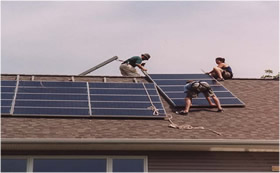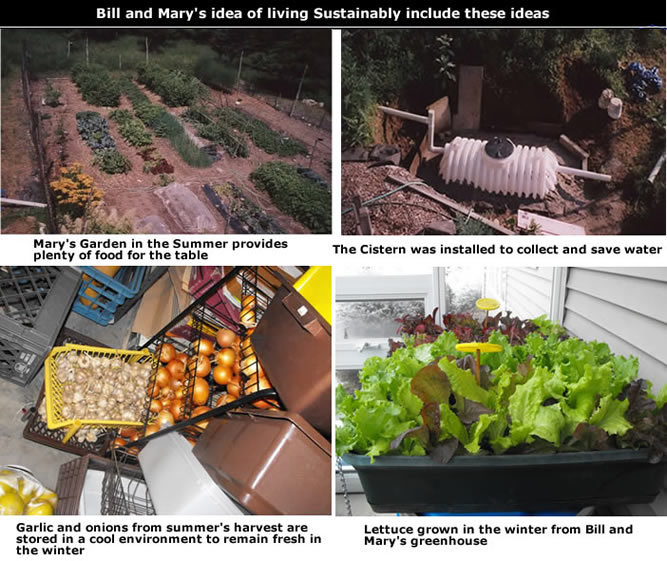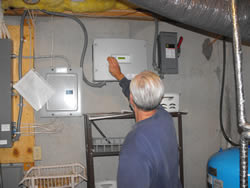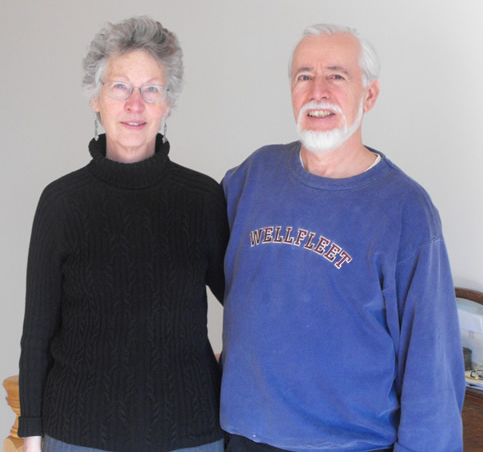 Warwick residents William and Mary Makofske have a passion for living sustainably, setting a sterling example while sharing their enthusiasm with others. Bill with a Ph.D. in physics has spent his life working on energy alternatives, both teaching and putting into practice his knowledge. As a professor emeritus, and having taught a variety of environmental courses, he is well versed on the environmental impacts of energy consumption, the benefits of renewable energy, and green building. Mary, a poet and former English Professor shares his passion, helping to create a lifestyle in which sustainable living is at the forefront. Between the two of them, Bill’s pursuit of turning sustainable living into a science and Mary’s into some kind of art form, the two have emerged as shining examples of what it means to be energy conservationists.
Warwick residents William and Mary Makofske have a passion for living sustainably, setting a sterling example while sharing their enthusiasm with others. Bill with a Ph.D. in physics has spent his life working on energy alternatives, both teaching and putting into practice his knowledge. As a professor emeritus, and having taught a variety of environmental courses, he is well versed on the environmental impacts of energy consumption, the benefits of renewable energy, and green building. Mary, a poet and former English Professor shares his passion, helping to create a lifestyle in which sustainable living is at the forefront. Between the two of them, Bill’s pursuit of turning sustainable living into a science and Mary’s into some kind of art form, the two have emerged as shining examples of what it means to be energy conservationists.
 One might say that living more sustainably starts with the basic foundations. For the Makofske’s, that was the case – who have been taking into account basic solar and energy efficiency principles from the inception of building their home. “When we built our home in 1998, we had a clear vision on where we wanted to go,” Mary states. “The compass we used determined the design of our house.” Quite literally, that is. The house is oriented to the south, with most of the windows and a greenhouse on the south side. The south roof has both solar electric and solar hot water panels. The building is airtight, highly insulated, with an air-to-air heat exchanger to bring in just the right amount of fresh air. They also found other ways to conserve energy, such as reducing the thermostat at night, and covering their windows with movable insulation to retain energy.
One might say that living more sustainably starts with the basic foundations. For the Makofske’s, that was the case – who have been taking into account basic solar and energy efficiency principles from the inception of building their home. “When we built our home in 1998, we had a clear vision on where we wanted to go,” Mary states. “The compass we used determined the design of our house.” Quite literally, that is. The house is oriented to the south, with most of the windows and a greenhouse on the south side. The south roof has both solar electric and solar hot water panels. The building is airtight, highly insulated, with an air-to-air heat exchanger to bring in just the right amount of fresh air. They also found other ways to conserve energy, such as reducing the thermostat at night, and covering their windows with movable insulation to retain energy.
As they have found more ways to conserve energy, correspondingly their savings have multiplied. Bill points out that they have not had to pay an electric bill for some time, although occasionally in the winter there is a small one. Noting that the average home might use 1200 gallons of oil a year, they have employed a variety of means to reduce that number to 100 gallons a year, envisioning a day in the not-too-distant future when their home will have achieved zero net energy.
Since 2003, as part of a national tour sponsored by the American Solar Energy Society, they have opened their home to the public, sharing their insights to help others who have the same desire to build an energy efficient solar home. Admittedly, I was naïve in my understanding about some of the issues surrounding ‘the sustainable home,’ thinking that I was going to walk into a home simply powered by wind, water and sun.
But I learned that their energy source, on a sunless winter day, is generated not from solar, but in part from their back-up oil burner. After all, we all know that Warwick, NY is not Arizona in terms of the sunshine factor. It’s the cumulative effect - from creating a solid efficient house to employing several energy systems to one’s everyday actions – that allows for cost reductions. And it starts with the basics, the not so glamorous side of conservation like weather stripping or super insulating your home, which Bill has given workshops on. Otherwise, “your house is like a sieve,” says Bill. “You can reduce heat loss significantly when you insulate properly, make it airtight, and employ air exchange systems.” These measures alone have saved them approximately 700 gallons of oil a year.
Like the homes of the ancient Anasazi Indians built facing southward to capture the warming benefits of the sun , so too is the home designed with conservation in mind. “The sun plays a primary role in supplying our energy needs,” says Bill. “Two-thirds of our windows, which represent over 8% to 10% of floor space, were installed on the south side of the house. Because the sun sits low in the south sky in the winter, south sloped roofs and windows will collect energy.” For those renovating or looking to buy an existing home, this is not a moot point. Bill calculates that due to the 200-square-ft. of windows facing their south side, they are able to save 200 gallons of oil a year because “each square ft. gains us a gallon of oil in terms of heat. When you do this, there is absolutely no extra cost.”

Adding a green house on the south side of their home also cut energy costs. “When the greenhouse door is left open on sunny days, it transfers heat to the house. Heat rises by natural convection and makes our house warmer.” Bill estimates that their greenhouse has saved them another 100 gallons of oil a year. On the winter day that I went, they were growing multiple heads of lettuce in February. At a $1.99 a head, I was calculating the savings to myself. Mary states, “obviously you can grow things in a greenhouse when normally you can’t.” Later in my tour, they showed me their perfectly cooled storage room, containing baskets of fresh garlic, leftover from the late summer months, plucked from their garden. And I might add, it wasn’t any old garden – it was a large plot of land.

Other measures, such as reducing the temperature at night, have brought down their energy costs further. Although commonsense, not everyone applies it. “For every degree you drop the thermostat, you save 2% on the cost of energy. Dropping the temp down from 68 to 60 an average of 8 hours a day over the course of the winter may yield you approximately 10% of your total energy costs. Not only do you save energy, but it is healthier for you, because it keeps the humidity higher, clearing out those nasal passages.”
The kind of windows installed may impact energy savings as well. For example, if you want windows that transmit more sunlight, then you have to accept that in winter, you may lose more heat from those windows. Their home uses double-paned windows with a low-emissivity coating , giving it a higher R Value. R is a measure of resistance to heat flow, so the higher the better. The extra R-value more than compensates for the drop in light transmission. But as he says, “you have to balance it - weigh each of these factors and make a decision.”
Bill and Mary were among the first people in Orange County to take advantage of the incentives and rebates provided by the federal and state government to add solar photovoltaics to their home. “I was waiting for the law to pass,” Bill says with relish as if a kid speaking about Christmas Day. But then he notes that it is a significant investment, one in which rewards are not reaped until further down the road, even with the approximately 50% government rebates. “A PV system may take 8-10 years to pay back, but it will likely last for 30 years.” The solar hot water heater was installed for $3000 when the house was built before tax incentives existed. All told, the solar PV, hot water heater, greenhouse, added insulation, and air to air heat exchanger cost less than $30,000, or about 15% of the cost of the house. Payback time varies for each of them, but they all pay back in less than 10 years.

Some people are not prepared to make that initial investment, nor are they certain they will be living in that home for the foreseeable future.” However, the investments make the house worth more at time of sale, since energy costs keep rising faster than inflation. In discussing other obstacles, public misperceptions are a factor. Mary says, “A lot of people don’t think it works, or that it is for people with fancy houses, or that it’s not practical. Or people will say ‘I can’t afford to buy solar panels.’ Yet those granite counter tops go in.” Bill adds, “There’s an investment. But the energy systems will last 30 years. It’s like building a power plant – not everyone is interested in building a power plant.”
 Their solar PV unit has provided them not only with savings, but a surplus of energy. While they pay a monthly connection fee of around $10, they are credited for excess energy, measured by a meter, something which Bill refers to as net-metering. Overall, the surplus is also applied on occasion to several electric heaters and to back up their solar water heater. These investments along with continued conservation mindedness have saved them approximately $5000 a year on their home energy costs. Living in their home for 11 years, those savings add up – to approximately $55,000. Since their new energy systems won’t need to be replaced for another 10 to 15 years, that’s money in the bank.
Their solar PV unit has provided them not only with savings, but a surplus of energy. While they pay a monthly connection fee of around $10, they are credited for excess energy, measured by a meter, something which Bill refers to as net-metering. Overall, the surplus is also applied on occasion to several electric heaters and to back up their solar water heater. These investments along with continued conservation mindedness have saved them approximately $5000 a year on their home energy costs. Living in their home for 11 years, those savings add up – to approximately $55,000. Since their new energy systems won’t need to be replaced for another 10 to 15 years, that’s money in the bank.
Yet success is not just measured in dollars and cents, but by other measures, such as environmental impacts and carbon footprints. Bill says, “People are not aware that when they use electricity, most of that electricity comes from coal-fired plants. Although it seems clean at point of use, the reality is that there is a coal plant belching out lots of CO2 into the environment.” When I inquired why a wood burning stove was not part of his overall strategy, he explained his concern with air quality in a tight house “wood smoke is toxic. Plus, it’s work to cut wood, clean ashes and fire up the stove. I’m not against using wood, but the more clean energy that is produced, the better.”
In terms of outreach, the two have participated in meetings involving Warwick’s efforts to find ways to reduce their carbon footprint. When told about Maplewood, N.J’s successful efforts to reduce energy use, they met with their mayor, along with various representatives from Warwick’s town and village government and several other key organizations to compile suggestions, one of which was creating a bike path, spearheaded by Sustainable Warwick. Bill has continued to be active with the town, as they have drawn on his expertise. In 2011, he was instrumental in shaping and writing a successful grant involving the purchase of 3 hybrid school buses and two electric charging stations, which have now been successfully installed in the village and the town and are being used to charge-up a new breed of electric vehicles like the Chevrolet Volt.
Mary too has not let up her efforts. One project involved using window mannequins to publicize the 350.org campaign to set a goal for 350 ppm carbon in the atmosphere. Mary says, “We gave out flyers, collected petitions, and paraded in a dragon costume downtown. The idea was to put pressure on the U.S. to push for a strong commitment at the climate conference in Copenhagen”(which she points out we didn't get). Mary was also directly involved in developing a reusable bag campaign in conjunction with Shop-Rite. Then there is the 10% Challenge, a program implemented by Sustainable Hudson Valley, which could also reduce the community’s carbon footprint. Mary says “The idea is to get existing groups to sign on to reducing some form of their energy use by 10% in one year. It's partly just raising awareness, encouraging people to see where their energy goes and how they can reduce it.”
Mary, who is a published poet, reflects those sustainable values in her writing.
Dear Editor
The light tracks me all day, sitting at my desk,
late afternoon now. Air holds its breath,
barely a tremble in the fountain grass,
the box elder leaning against the glass,
a small plane droning low over the hills.
Does it seem leisurely? Does all seem well?
Today I composed more and more
fervent letters to the editors
of every local paper, why it must change,
why we must think who we are, as the same
that is never the same turned over leaves
that flamed or quietly browned. What dies,
what thrives in the garden every year
is different, unpredictable. Our share’s
enough, we can’t change the weather,
we used to say, though now we know better.
Too late moves toward us faster
than the fast-retreating glaciers.
Published by Amoskeag.
Clearly, there is a lot to learn from the Makofskes, who have taken knowledge of natural energy flows and turned it into a lifestyle art form. Which all adds up to living in a better, cleaner world. Still working to reach a better score, however, this couple is not resting on their laurels, nor sitting tight in their fuel efficient Toyota Prius. They are the first to learn from their experiments, always seeking improvement, both in their personal progress and the world they will leave to the next generation.
Thank you Bill and Mary.

